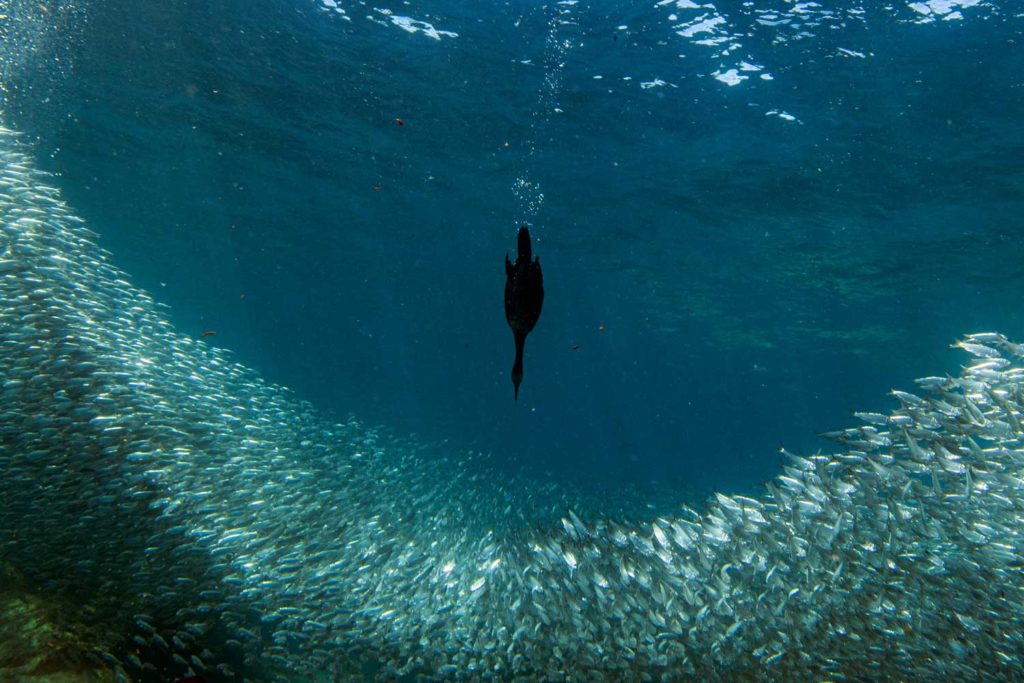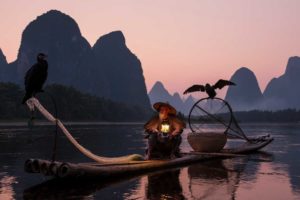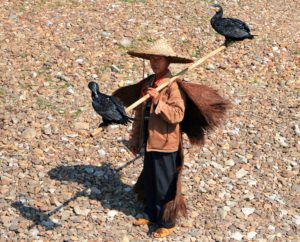
Laurence Coulton
Extract from WildChina
The chief flesh food in the erstwhile Celestial Empire consists of the fish found in the streams and canals which everywhere abound. To catch these fishes, the Chinese have probably devised more interesting and ingenious apparatuses than any people in the world.
So wrote Dr. E W Gudger in an article for The American Naturalist in 1926. As an ichthyologist, Gudger was interested in all things fish, but in this particular piece he was setting the scene for one of China’s most unique and enduring traditions.
 Cormorant fishing is a spellbinding example of human synchronicity with nature. While techniques vary from place to place, hatchlings are usually trained from birth, either by socializing with older domesticated birds or through a system of gradual rewards which incentivize them to cooperate with their human masters.
Cormorant fishing is a spellbinding example of human synchronicity with nature. While techniques vary from place to place, hatchlings are usually trained from birth, either by socializing with older domesticated birds or through a system of gradual rewards which incentivize them to cooperate with their human masters.
Once old enough, a band is carefully placed near the base of the cormorant’s slender throat which prevents it from swallowing larger fish. Upon the river, fishermen lure their prey with lights or by agitating the surface of the water. This encourages the birds to dive.
 The cormorant, master of the shallows, cuts through the water, chasing down fish with remarkable speed and precision. Once a catch is made, the birds instinctively return to the boat or raft, where the fish is removed from their throat and they are rewarded for their efforts with a lesser prize.
The cormorant, master of the shallows, cuts through the water, chasing down fish with remarkable speed and precision. Once a catch is made, the birds instinctively return to the boat or raft, where the fish is removed from their throat and they are rewarded for their efforts with a lesser prize.
This may seem unfair, but the relationship is more equitable than it appears. Cormorants are said to possess the mathematical skill to tally their catch, and if they feel insufficiently compensated for a day’s haul they will no longer cooperate with their partners.
In this age-old fashion, a good cormorant-fisherman team can catch several dozen fish a day. […]
Accounts show that the kings of France and England enjoyed fishing this way for sport, so much so that the latter had a specialist Master of Cormorants to take care of his birds. Although cormorant fishing never caught on as a profitable industry in Europe, the indulgence of occidental royalty is testament to its enduring charm for western observers.
 By the twentieth century cormorant fishing was booming in many of the places we associate with it today. Archive footage from 1931 shows scores of fishermen near Guilin, their cormorants churning the tranquil waters of the Li river.
By the twentieth century cormorant fishing was booming in many of the places we associate with it today. Archive footage from 1931 shows scores of fishermen near Guilin, their cormorants churning the tranquil waters of the Li river.
Yet despite this recent heyday, cormorant fishing is now a dying art. As with so many traditional industries, competition from modern techniques has rendered it ever more obsolete. A decline in fish populations, especially on the Li, has made the situation even more untenable.
This 1,300-year-old tradition is now predominantly practiced for the entertainment of tourists, performed by an ever-decreasing number of elderly men who have been fishing this way their entire lives. […]
This increased interest from tourists offers a new sustainable future to cormorant fishermen in places like Yangshuo and Dali’s Erhai Lake. Motivated by the chance to make a living by following in the footsteps of their fathers, younger fishermen are starting once again to take up the craft.
It may be largely for our benefit, but the theater of these geriatric fishermen and their faithful birds is keeping alive a unique tradition which, without them, may already have faded into the semi-mythical realm of historical memory.




